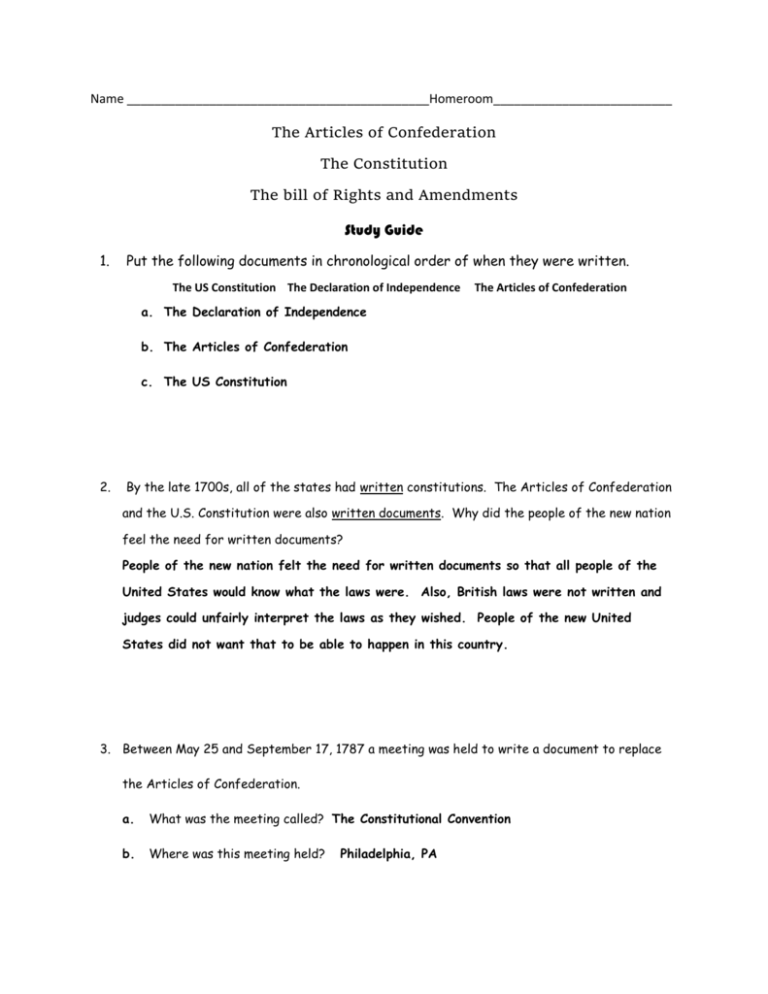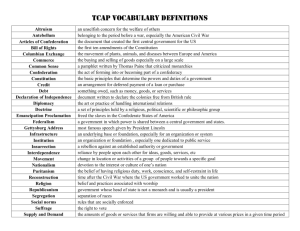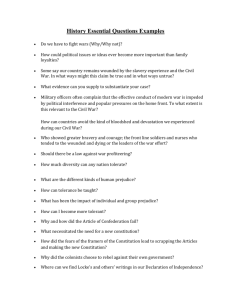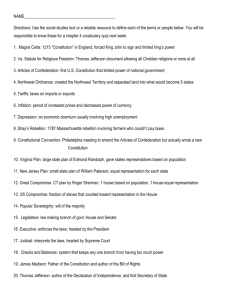Name The Articles of Confederation The Constitution The bill of
advertisement

Name ____________________________________________Homeroom__________________________ The Articles of Confederation The Constitution The bill of Rights and Amendments Study Guide 1. Put the following documents in chronological order of when they were written. The US Constitution The Declaration of Independence The Articles of Confederation a. The Declaration of Independence b. The Articles of Confederation c. The US Constitution 2. By the late 1700s, all of the states had written constitutions. The Articles of Confederation and the U.S. Constitution were also written documents. Why did the people of the new nation feel the need for written documents? People of the new nation felt the need for written documents so that all people of the United States would know what the laws were. Also, British laws were not written and judges could unfairly interpret the laws as they wished. People of the new United States did not want that to be able to happen in this country. 3. Between May 25 and September 17, 1787 a meeting was held to write a document to replace the Articles of Confederation. a. What was the meeting called? The Constitutional Convention b. Where was this meeting held? Philadelphia, PA 4. Write each fact under the document that it describes. -created the first national government for the new nation -set up the national government to be weaker than the state governments -sets up three branches of government and explains how they work -proved to be too weak and was replaced by another document - still in use as the “rule book” for the US government today -national government and state governments divide power, roles and responsibilities Articles of Confederation: 1. -created the first national government for the new nation 2. -set up the national government to be weaker than the state governments 3. -proved to be too weak and was replaced by another document U.S. Constitution: 1. -sets up three branches of government and explains how they work 2. - still in use as the “rule book” for the US government today 3. -national government and state governments divide power, roles and responsibilities 5. The beginning section of the U.S. Constitution tells the goals and purposes of the government. What is this section called? (It starts with the famous words “We the People…”) The Preamble 6. Match the words of the Preamble to the more simple way of saying what that part means. 1. “establish justice…” a. create fairness 2. “insure domestic tranquility…” b. defend the country 3. “provide for the common defense…” c. make sure that everyone and their descendants has freedom 4. “secure the blessings of liberty to ourselves and our posterity…” d. keep peace within the country 7. What are the three branches of government? a. Executive Branch b. Legislative Branch c. Judicial Branch 8. What is a federal system of government? A federal system of government divides the power of government between the national government and the government of the states. 9. Why did the framers of the U.S. Constitution include “checks and balances” between the three branches of government? A system of checks and balances gives each of the branches of government ways to limit the powers of the other branches. No one branch can become too powerful. 10. Put each word or phrase under the correct branch of government that it describes. President Supreme Court -makes laws -carries out laws Legislative Congress -decides if laws are constitutional Judicial Congress Executive Supreme Court -makes laws -decides if laws are constitutional President -carries out laws What is a change to the Constitution called? An amendment 11. How many such changes have been made? 27 12. What is the Bill of Rights? The Bill of Rights is part of the Constitution. It includes the first ten amendments. It describes the basic freedoms of the citizens of the United States that the government cannot take away. 13. Match the rights from the Bill of Rights to the example of that right. a. freedom of religion 1. You can worship as you choose. b. freedom of speech 2. You can go to meetings. c. 3. You are allowed to choose your president. freedom of the press d. right to vote 4. A newspaper can publish people’s opinions. e. Right to assemble 5. You can criticize your government. f. right of trial by jury 6. A group of people will decide what happens to you if you commit a crime.






